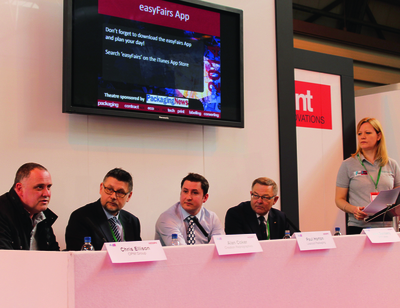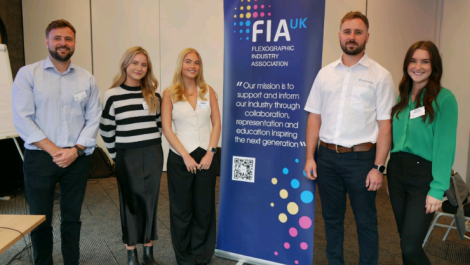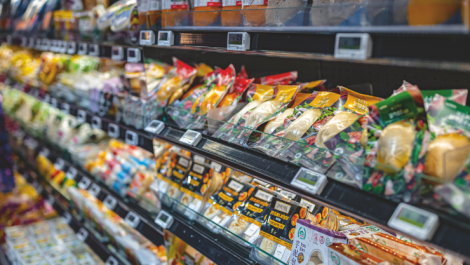The future of flexographic printing was in focus on the first day of the Packaging Innovations show, at the NEC in February. As part of the learnShop programme, FlexoTech editor, Neel Madsen, chaired a debate on how flexo can achieve the high quality packaging that brand owners demand, while at the same time offer cost savings over other technologies.
In recent years, flexo has made significant progress in terms of control of the process and can today produce exceptional print quality. A number of drivers are pushing the technology forward, and this discussion focused on how the industry is responding to demands for shorter runs, sustainability and cost efficiency whilst still delivering the high quality print demanded by brand owners.
The panel consisted of four people who all have many years’ experience in the flexo industry: Alan Coker, business development manager at Creation Reprographics, Paul Horton, studio manager at Learoyd Packaging, Chris Ellison, owner of OPM Group, and John Bambery, the chairman of BPIF labels.
Taking costs out
Starting off the debate, Ms Madsen asked, ‘We are talking about reducing costs and at the same time matching brand colours and producing high quality packaging print. How do you achieve that with flexo?’
Paul Horton said that Learoyd Packaging has been very successful in taking customers from gravure to HD Flexo and that now the quality is established, the next stage is offering extended colour gamut printing with a reduced number of colours, ie achieving 80-90% of the Pantone colours with just four, five or six colours on press. ‘A lot of savings can be achieved simply by being more efficient and fully utilising the benefits of HD Flexo, reducing the dot size, and now also reducing number of colours and the need to split line and tone.’
Chris Ellison said that they are always looking at achieving brand consistency across a wide range of substrates, and that it is much easier to do so when you are working on a stable platform. OPM has introduced CMYK extended colour gamut printing for two reasons, one to drive efficiency into the value market, and two to control consistency on the higher value added market. ‘By reducing the number of colour stations on the press, you are also able to add other decoration processes for added value,’ he said.
Creation Reprographics decided 18 months ago that the best route to take to achieve cost savings and produce high quality print was to invest in waterwash plate processing technology, said Alan Coker. ‘It gives us cost advantages for our clients, and bringing something new into the equation has worked extremely well for us as we are able to meet our brand owner customers’ demands and targets.’
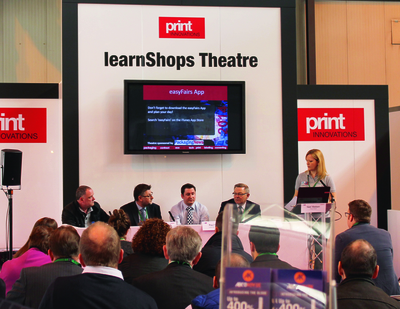
John Bambery said, ‘I think it is very interesting what has happened in flexo in the last few years. There was a big push into digital but its restrictions in terms of colour gamut has forced printers to compromise, and in turn, brand owners to compromise on brand colours. This has benefited flexo as the industry has had to look again at quality and work hard to print more Pantone colours with just six colours. Added to that digital repro is far more sophisticated that it has ever been enabling companies to take onboard HD Flexo and wider gamut printing. It is a very interesting development and I think the crossover point between digital and flexo is going to drop in favour of flexo.’
Mr Ellison commented, ‘A typical 8 or 9 colour UV flexo press only runs about 50% of the time it is switched on. If set up times, wash up and downtime in general can be reduced along with only using standard anilox rollers and standard mono-pigmented inks, along with modern plates and platemounting techniques, then the utilisation can be greatly increased. Taking the variables out of the flexo process offers great benefits and the results are absolutely spot on, plus you achieve the consistency that is paramount to the brands.’
Mr Horton agreed, ‘Using the fixed colour palette has reduced colour matching times from half an hour per colour to maybe 10 to 15 minutes with semi-automatic platemounting.
The control we now have over the whole process has required a complete culture shift and the efficiency we have achieved is absolutely critical to us and to our customers.’
Driving efficiency
Turning to the issue of sustainability, Mr Coker explained that Creation is planning to make its whole operation carbon neutral this year. The company will be making its waterwash plates using solar power and rain water as well as involving all employees and processes to ensure that ‘Project Zero’ is a success. Mr Ellison added that even for printers using the equipment and technology they have today without making new investments, there are still huge savings to be had by making the printing process more efficient in terms of using less ink, creating less waste for landfill, reducing downtime and using less energy overall.
Following up on the point made by Mr Bambery, Mr Coker said that Creation is taking work away from digital with many printers returning to flexo. This currently represents the company’s biggest growth area.
‘The whole printing industry, not just flexo, is going to have to pay more attention to lifecycle analysis in the future and look at press specifications that can reduce the amount of waste created and lower the energy consumption. There is going to be far more emphasis on implementing cost saving measures and we will become a more efficient industry as a result which in turn will lead to better sustainability with better use of resources,’ said Mr Bambery on the topic of sustainability.
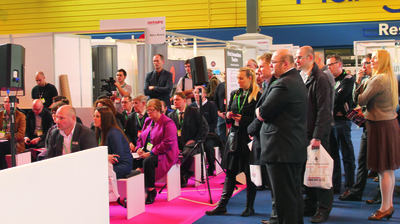
Future flexo
Driving these process efficiencies and printing stability is taking flexo into new markets. One such is printed electronics, which OPM has been involved in with a number of partners. Mr Ellison said, ‘This is one of the most exciting markets we are seeing at the moment and I believe that flexo, be it UV, water or solvent, has a key part to play in that. I see this as a major avenue for the process to follow.’
Mr Horton said that it was the introduction of HD Flexo into the market that really accelerated the developments in recent years enabling this very mature industry to take jobs away from gravure. ‘This is a trend that will continue,’ he said. ‘The rising prices of commodities are putting huge pressures on the industry and this will keep driving the development of fixed palette printing and cost reductions.’
Mr Ellison agreed, ‘Fixed palette printing will drive the overall standard of flexo printing. The housekeeping with this process has to be a lot tighter than what the majority of printers have been used to working with, and that will raise the standard across the board for the industry.’
Mr Horton said that it is important for printers to show the high quality of printing that flexo can achieve and try to dispel the myths that still surround it. Learoyd is now working closer with design agencies upstream and getting involved earlier in the process. He said, ‘We have to get past the ‘brand guardians’ as the ceiling that stops us from engaging with designers. We have to change the whole mentality of the job arriving on a Thursday and be printed on the Saturday, and become involved right from the start of a project so we can manage expectations.’
‘The future is very rosy for flexo,’ said Mr Bambery. ‘It is a sector that is not influenced by digital to the extent that the commercial sector has been, such as newspapers and books. Flexo is centred around packaging and these are tangible products that will always be needed so the future in those terms is secure.’ He too mentioned printed electronics as an exciting new development and said that there are many other new products that will drive flexo forward, but that take-up is too slow.
‘We are brilliant at coming up with new technologies but too slow at taking these initiatives and driving them forward. I don’t want the UK flexo industry to lose out to the Germans or the Japanese because we are not showing enough inititative. It is about taking these technologies to the brand owners and showing them what we are capable off,’ he said.
Training is key
Mr Bambery also raised the issue of training. ‘Flexo will only really go forward with proper training and we have staff that can take full advantage of the technology. A new press will only run to full capacity if the operator has been trained to use it correctly. We need a well trained and motivated work force for the future.’
Mr Horton agreed saying that Learoyd sends its staff out to Germany to be trained by the manufacturer in how to run the press, but that it goes further than that, and there is a need to upskill the whole workforce to give them a broader understanding of the issues involved, such as colour management. He said, ‘We don’t just want the operators to press the button. We want them to understand why they are pressing the button and the technology that lies behind it.’
‘Training is an essential part of any business; it is part of the due diligence of the business that you have got to have proper training in place,’ commented Mr Ellison before concluding, ‘At the end of the day, what will drive flexo forward is the demand from our customers. We are going to continue to be innovative in terms of product quality, image quality and sustainability, and of course, the dreaded word ‘costs’. Flexo is a great platform that can be used across a multitude of substrates and right across the whole packaging industry. It is very versatile, we can even print on balloons!’

